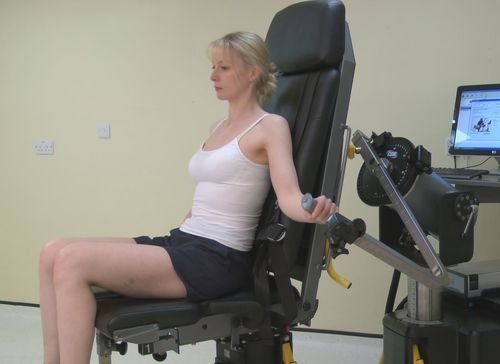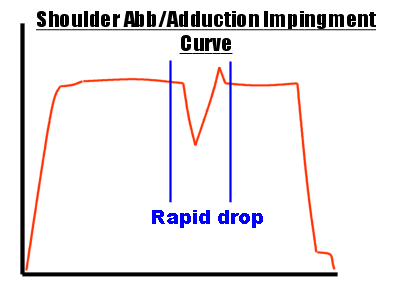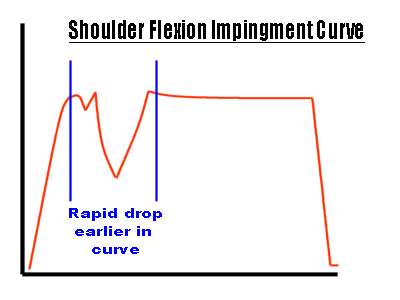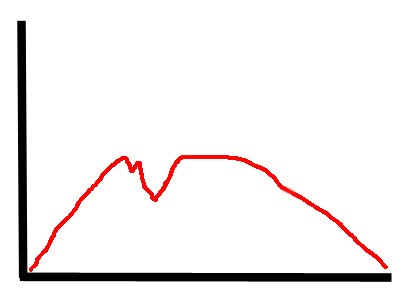These movements can be performed in either the standing or seated positions.
There are currently no standard examination positions for abduction and adduction of the shoulder. During the movements of the gleno-humeral joint there are always relative movements within the scapulo-thoracic junction. These are usually described as fitting a set of established normal patterns. These must be considered when testing the shoulder. When testing or exercising the shoulder it is vital that the subject has sufficient warm up before performing any movements.
Seated position:
In this position there is the increased innate thoracic stability (little rotation occurs) but adduction is severely limited as the subjects body stops the movement at anatomical zero. In this position the thoracic belts should be utilized to prevent upper body movements. Best for patients and research.

To view a set up video see below
Standing position:
In the standing position (see below) stabilization is difficult if not impossible (and probably undesirable). Testing in this position is more functional than that in the seated position and allows some adduction.

Stabilisation:
Standing: Stabilistion in the standing position is not normally required as this is the most functional position.
Seated: in the seated position stabilisation usually involves a lap belt and chest straps.
Attachments:
There is validity in using a wrist strap (as seen in standing above) rather than a grip handle (as seen in seated above) because this eliminates the influence of the wrist flexors and extensors. Although this may have some face validity it does not translate into real world testing. The hand grip is then always preferable.
Make sure the elbow has a small degree of flexion throughout the range to ensure it’s safety (5 degrees is usually enough).
Axis of rotation:
Regardless of the position of the test the alignment of the instantaneous axis of rotation should be a point roughly 2-3 cms below the inferior lip of the acromial arch. But it has been shown by Walmsley (1993) that the gleno-humeral joint as a whole (never mind its instantaneous axis of rotation) moves by an average of 8cm through range so the need for accuracy must be questioned.
Anatomical zero:
With arm by side of body.
Range of motion:
Generally a large range of motion is chosen for these tests. Generally 0 degrees to 160 and in some cases 180 degrees abduction have been used. Adduction is tested less often (most researchers use adduction from abduction or horizontal abduction / adduction), however anything from 0-40 degrees can be used.
Some testers will test the first 60-90 degrees of abduction with one axis then the remaining motion (which could be described as elevation anyway) with a different axis.
Gravity correction:
As the lever arm can be very long and heavy in these movements setting of gravity correction is essential. In patients gravity elimination (Humac Norm) can be very beneficial to reduce ballistic forces.
Speeds:
As velocities in some sports (any involving throwing an object) are known to reach thousands of degrees/second (Pappas et al., 1985) testing using a dynamometer been said to be non-functional. However, speeds over 300 degrees/second have been found to be difficult to achieve by even baseball pitchers (Cook et al., 1987). This could be said to suggest that muscular effort starts the motion but only occurs at slower speeds with momentum and acceleration playing a larger role later in the speed of the motion later through range rather than pure strength. Even if this speed could be achieved it is over such a small arc that the results gained would likely be fruitless.
Generally it is accepted that speeds of 60 degrees/second and multiples of this should be used.
Shoulder Abduction / Adduction Protocols:
Muscles involved:
Lateral deltoid and pectoralis major, latissimus dorsi
| Strength Test Protocols | General | Patients | Athletes | Research |
| Contraction Cycle | con/con | con/con | con/concon/ecc | con/conecc/ecc |
| Speed/s | 60 or 120 | 60 or 120 | 60-300 | 60-500 |
| Trial Repetitions | 0 | 0 | 0 | 3 |
| Repetitions | 10 | 10 | 10 | 5 |
| Sets | 3 | 3 | 4 | up to 9 |
| Rest between sets | 20-30 secs | 20-30 secs | 20-30 secs | 20 secs |
| Rest between speeds | 2 minutes | 2 minutes | 2 minutes | 2-5 minutes |
| Rest between sides | 5 minutes | 5 minutes | 5 minutes | 5 minutes |
| Feedback | nil | nil | nil | nil |
| Endurance Test Protocols | General | Patients | Athletes | Research |
| Contraction Cycle | con/con | con/con | con/concon/ecc | con/conecc/ecc |
| Speed/s | 120 | 120 | 120-300 | 120-500 |
| Trial Repetitions | 0 | 0 | 0 | 0 |
| Repetitions | Max | Max | Max | Max |
| Sets | 1 | 1 | 1 | 1 |
| Rest between sets | N\A | N/A | N/A | N/A |
| Rest between speeds | 10-15 mins | 10-15 mins | 10-15 mins | 10-30 mins |
| Rest between sides | 5 mins | 5 mins | 5 mins | 5 mins |
| Feedback | nil | nil | nil | nil |
| Strength Exercise Protocol | General | Patients | Athletes |
| Contraction Cycle | con/con | con/con | con/ecc |
| Speed/s | 60 up to 180 | 60 up to 180 | 60-300 |
| Trial Repetitions | 0 | 0 | 0 |
| Repetitions | 10 | 10 | 14 |
| Sets | 6 | 6 | up to 12 |
| Rest between sets | 30-60 secs | 30-60 secs | 30 secs |
| Rest between speeds | 2 mins | 2 mins | 2 mins |
| Rest between sides | Nil | Nil | Nil |
| Feedback | bar | bar | bar |
| Endurance Exercise Protocol | General | Patients | Athletes |
| Contraction Cycle | con/con | con/con | con/con |
| Speed/s | 120-180 | 120-180 | 120-300 |
| Trial Repetitions | 0 | 0 | 0 |
| Repetitions | Max | Max | Max |
| Sets | 1-3 | 1 | 1-3 |
| Rest between sets | 5-10 mins | N/A | 5-10 mins |
| Rest between speeds | 10-30 mins | N/A | 10-30 mins |
| Rest between sides | Nil | Nil | Nil |
| Feedback | bar/pie chart | bar/pie chart | bar/pie chart |
Notes:
Test the uninvolved or dominant limb first. Abduction beyond 600 produces high variability in results.
Interpretation:
In the shoulder it is normal to look at the ratio between the right and left sides there should be a 0-10% difference between the sides. Anything beyond this would either demonstrate extreme hand dominance (this can happen in certain sports like javelin), or indicate a muscle imbalance which would be best corrected.
Eccentric results are generally 30% higher than concentric within the same muscle.
Angle of peak torque for abduction is -30 degrees although this can vary as much as 40% (that is 30 degrees in abduction (Bober et al 2002)
Angle of peak torque for adduction 90 degrees although this can vary as much as 40% (that is 90 degrees of abduction) (bober et al 2002)
Anterior Impingement Curves:
During the mid range of abduction and adduction a sharp and significant drop is often seen. See below.
This is because the anterior structures are most vulnerable to impingement in this position (in isokinetic terms that is).

In flexion a drop appears at the start of range. See below.
This is because the anterior deltoid locates the gleno humoral joint before lifting it.
This can impinge anterior structures.

Sub Achromial Bursitis:
The curves are similar to that seen in shoulder impingement but the peak torque is usually much lower.
Graph shown for abduction concentrically.

Normative values:
| Berg et al. (1985) | Age | Sex | Machine | Peak mean (SD) | Peak mean (SD) |
| speed deg/s | 20-26 | f | Cybex | Abduction | Adduction |
| 60 | 34.5 | 44.5 | |||
| 120 | 31.9 | 40.2 | |||
| 180 | 28.7 | 34.2 | |||
| 240 | 23.7 | 29.1 | |||
| Cahalan et al. (2001) | 21-40 | M/F | Cybex | ||
| 60 | 48(11) | 90 (21) | |||
| 180 | 40 (10) | 72 (16) | |||
| 300 | 33 (11) | 60 (16) | |||
| Wilk et al. (1992) Trowing Athletes | Biodex | ftlbs Dominant | |||
| 180 | 68.1 (12) | ||||
| 300 | 40.3 (15) | ||||
| ftlbs Non Dominant | |||||
| 180 | 62.5 (10) | ||||
| 300 | 38.4 (14) | ||||
| Biodex Values | N/A | M | Biodex | PTBW Goal | PTBW Goal |
| 60 | 20-27 | 32-43 | |||
| 180 | 18-24 | 27-36 | |||
| F | |||||
| 60 | 16-20 | 27-35 | |||
| 180 | 14-18 | 25-33 |
Values for adductor group concentric and eccentric strength (in Nm). Based on Ivey et al (1985), Cahalan et al (1991) and + Shkiar & Dvir (1994) sedentary subjects.
| 600/s | 1200/sec | 1800/sec | 3000/sec | |
| Concentric | ||||
| Men | 99 | 71 | 86 | 77 |
| Women | 51 | 32 | 45 | 35 |
| Eccentric | ||||
| Men | 93 | 97 | ||
| Women | 46 | 50 |
Values for abductor group concentric and eccentric strength (in Nm). Based on Ivey et al (1985), Cahalan et al (1991) and + Shkiar & Dvir (1994) sedentary subjects.
| 600/s | 1200/sec | 1800/sec | 3000/sec | |
| Concentric | ||||
| Men | 53 | 50 | 43 | 40 |
| Women | 28 | 27 | 19 | 16 |
| Eccentric | ||||
| Men | 66 | 73 | ||
| Women | 37 | 41 |
Ivey et al (1985) looked at shoulder adduction/abduction ratios and found the adductors are normally 2x the strength of the abductors:
| Alderink & Kuck (1986) | Dominant Side % (sd) | Non Dominant Side % (sd) | Average % |
| 30 | 0.63 (0.21) | 0.66 (0.24) | 0.65 (0.19) |
| 60 | 0.43 (0.14) | 0.44 (0.11) | 0.44 (0.11) |
| 90 | 0.37 (0.13) | 0.38 (0.13) | 0.38 (0.12) |